Here are the archived images I have collected so far.

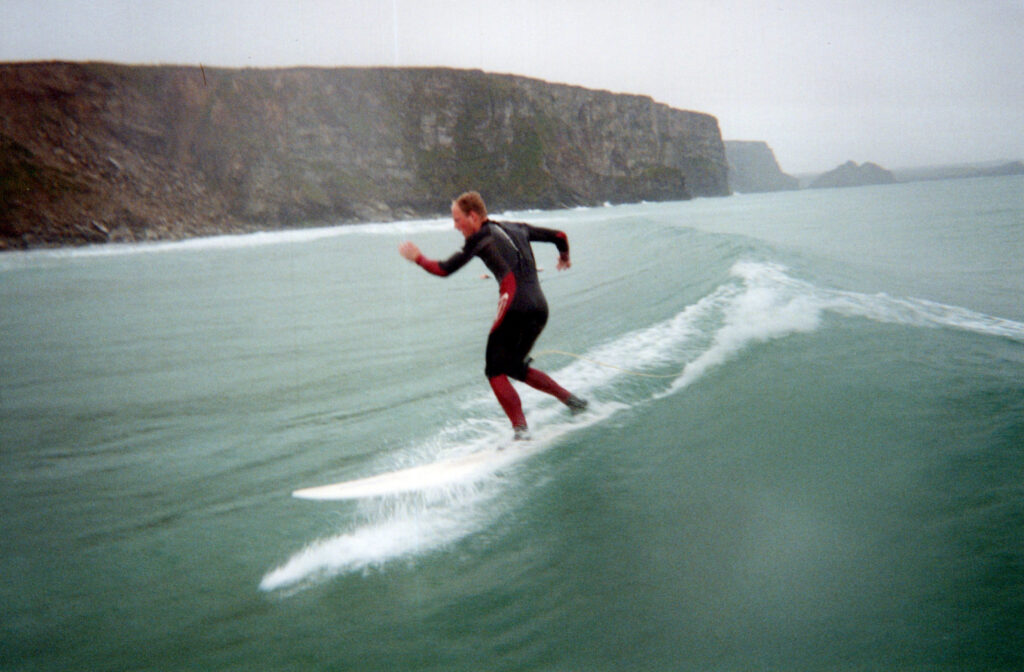
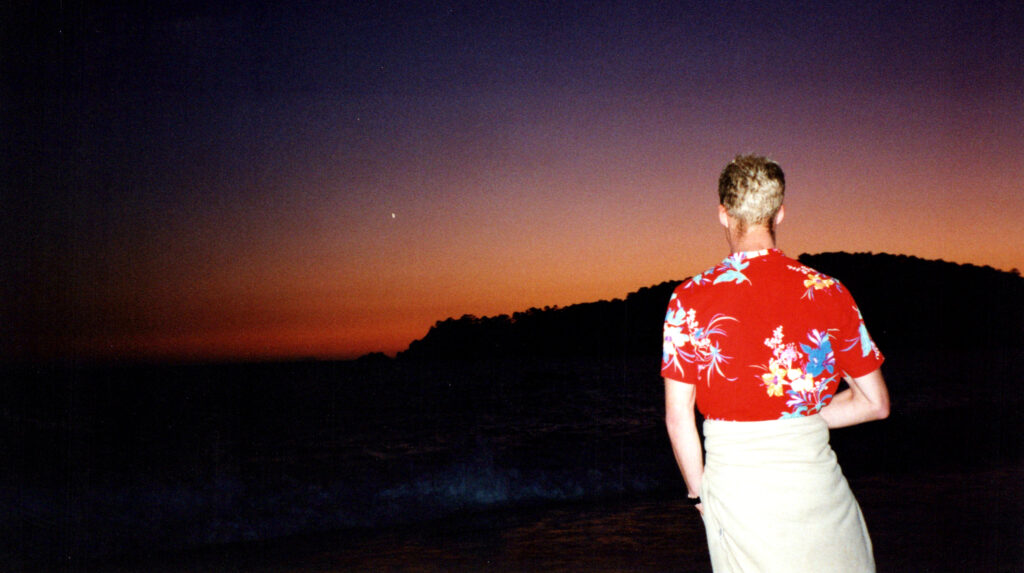


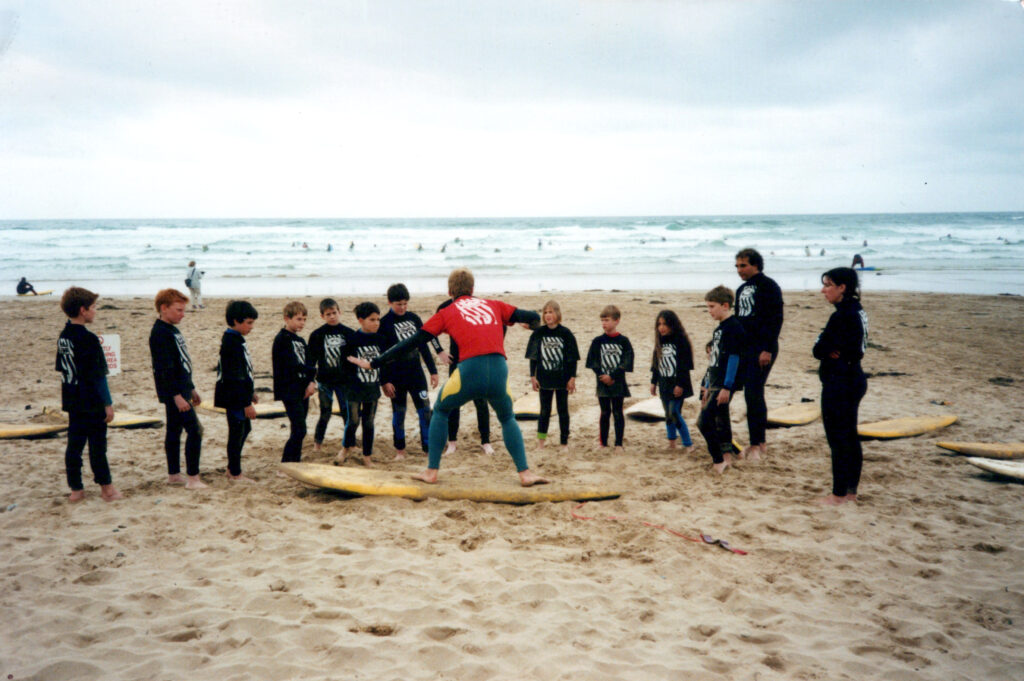
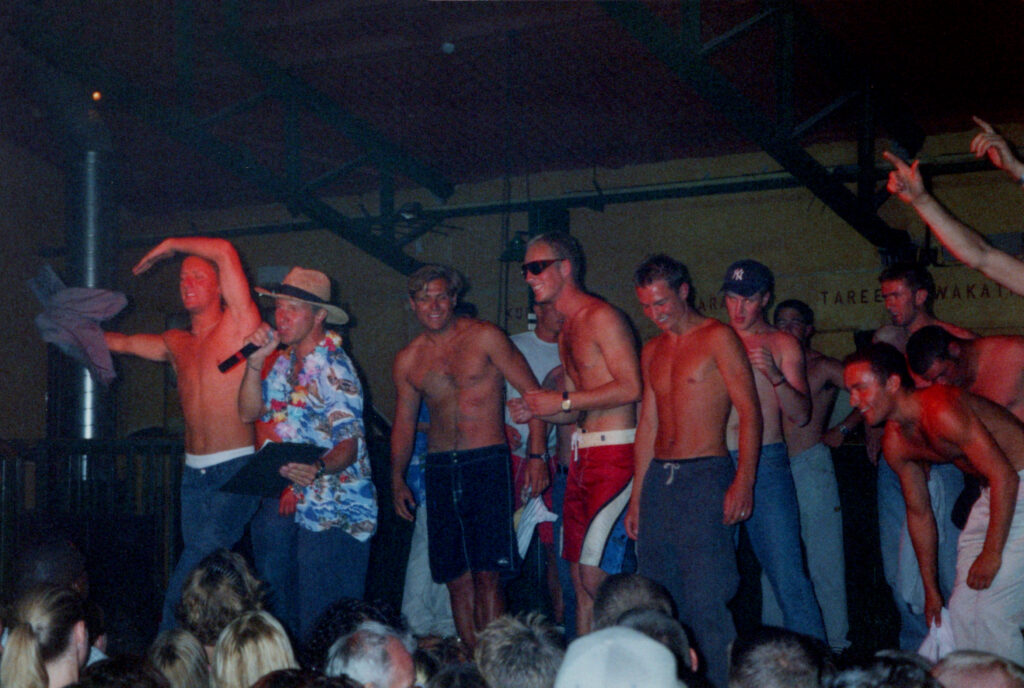
Here are the archived images I have collected so far.







Academic Sources
Essay Plan
Make a plan that lists what you are going to write about in each paragraph – essay structure
I will be discussing the importance of photography both in cultivating the mindset of the viewer toward the subject and in communicating a message visually. I will be analysing the work of W Eugene Smith, Robert Capa, Dorothea Lange. This is because their work all serves a function to tell a story – whether this is a true or untrue story.
The first images were portraits; staged and set up by the photographer in a studio. photography equipment was big and clunky and inconvenient; was easier to stage images than capture in-the-moment shots. Ever since photography began, photographers have lied; use of sky overlays on old landscapes/ Trotsky’s erasure from images where he stood close to Lenin etc. to communicate a person’s story through images is to make it accessible for someone who lives an entirely different life on the other side of the planet; very important in times where travel was expensive and uncommon (W. Eugene Smith) . They also help us understand history and what life used to be like; by making different choices, photographers can ultimately alter history itself.
W. Eugene Smith uses his work to document the lives of people he personally finds interesting. He uses the structure of shots (e.g. establishing shot, person at work etc.) that works to entirely showcase every aspect of the person’s work and home life, thus communicating what he personally finds interesting. this is important in a world with little technology/travel etc.
Robert Capa’s image is highly debated as to whether it was staged or not. some may argue this is an unprofessional trait in a war photographer, but it demonstrates his integrity and ability to stay true to his own vision. arguably only seen in this example however
Dorothea Lange’s Mother and baby of family on the road is important because instead of the later, more staged version taken after, the first, more despairing image is used by Lange. this then becomes the Farm Security Administration’s representation of the Great Depression; the importance of this image echoes down the ages and shows how our view of documented history is almost entirely dependent upon the images we have to show for it.
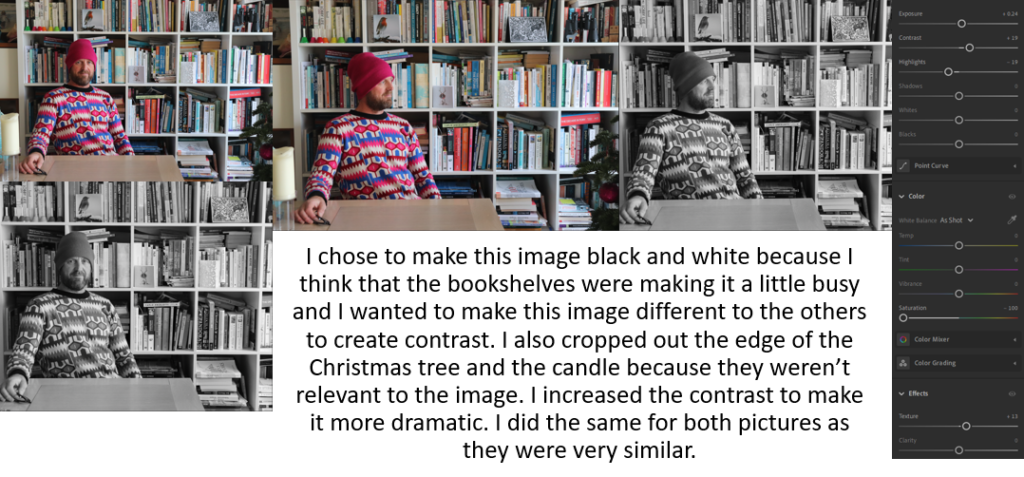



I took a small collection of images on Christmas Day when my dad went for a swim, I also later took more environmental portraits in the home and some establishing shots of the surfboard/wetsuit/surf book collections that can be found in our house.

I edited my images on Adobe Lightroom.


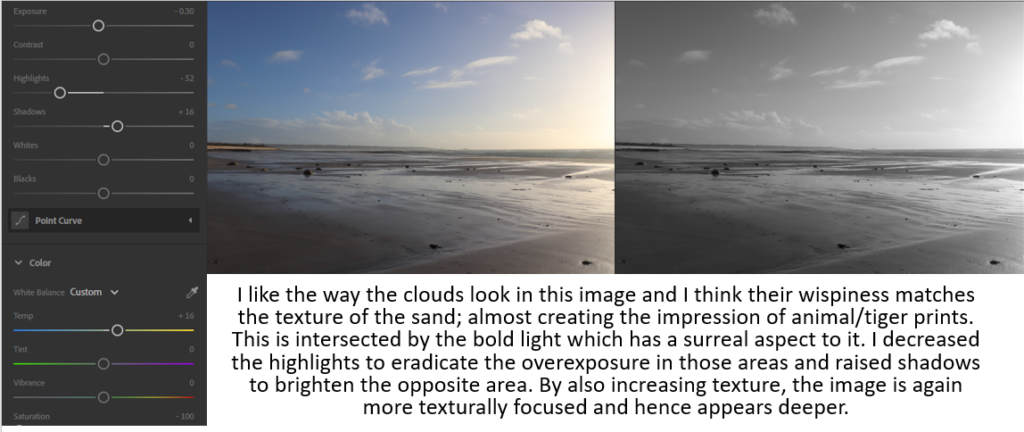


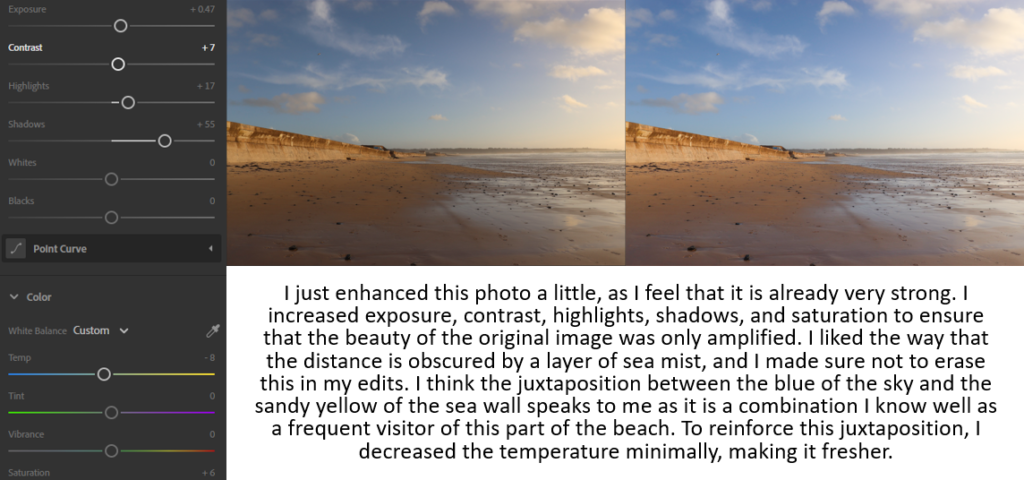







Photoshoot 1/2:
I will do my first photoshoots at St Ouen’s beach as this is very near to my house and I cannot begin to take portraits just yet because my dad is currently away. I will try to capture the details, especially those seen by a surfer, as well as a wider view of the bay. I think that this will be important in order for me to set the scene for other images. I will do this in two (+) shoots to allow me to capture the effects of different weathers on the beach and the sea. These images will be most similar to Michael Marten‘s work, which will allow for a documentary style photographing of the subject.
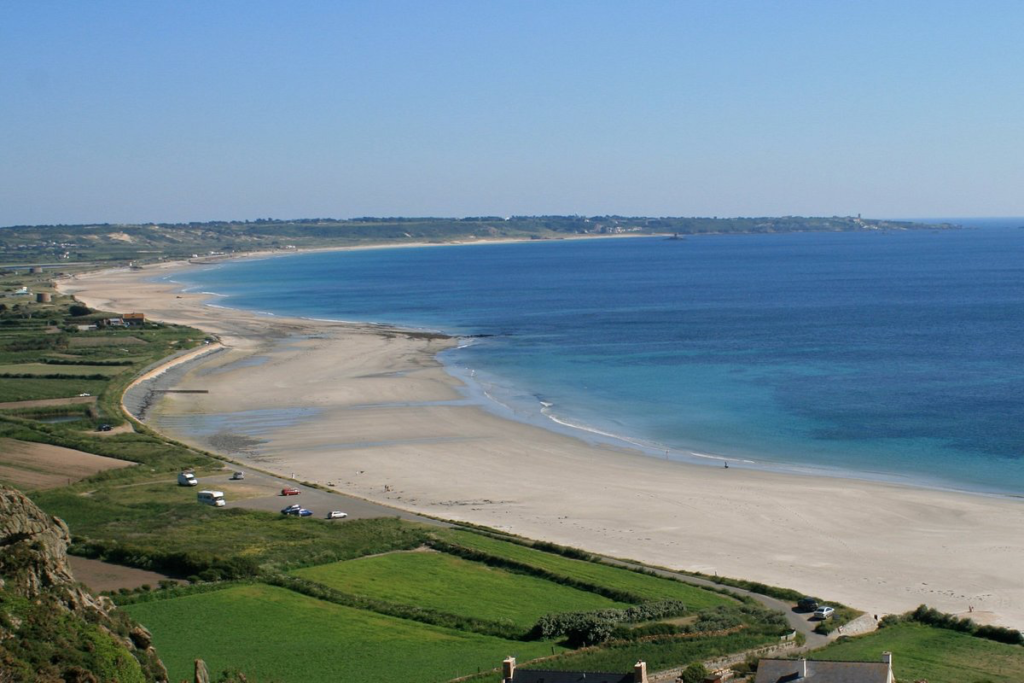

Photoshoot 3/4:
Later, I will follow my dad on a few trips to the sea and photograph his movements on the way. I will also capture aspects such as water texture here and go for a documentary style series of portraits. This may be at St Ouen’s, but may also be in other places where my dad surfs, such as St Brelade, Greve de Lecq, and Plemont bay. Perhaps if my dad surfs/swims on Christmas Day this would be a good shoot as well. These will be more similar to the work of artists such as Thomas Lodin and also W. Eugene Smith.






Photoshoot 5:
I will photograph my dad in the house in a more environmental style, either in the garage alongside all the surfboards and wetsuits or in the main house, perhaps looking out of the windows at the surf in the distance as he often does. This will be an important part of the study because it will show how he lives his life at home. These images will be linked to the work of environmental portrait artist Arnold Newman.


W. Eugene Smith (1918-1978) was perhaps the most famous documentary photographer of all time. A member of the Magnum photography group from 1955 to 1958, Smith’s most famous work is arguably his 1948 Life magazine photo essay, Country Doctor. I will be looking at Smith’s work because he is a pioneer of the documentary photo essay and, as I want to tell my Dad’s story to the best of my abilities, Smith’s methods are of great interest to me.
He first began photographing at age 14, taking photos of airplanes at a local airfield, and became a photographer for two local newspapers within a year. After attending college (University of Notre Dame, for which he obtained a photography scholarship) for one year, he left for New York City at 18.
After a brief stint at Newsweek, where Smith was fired because he refused to move to large-format negatives from his beloved 35mm Contax, Smith was employed as a war correspondent for Life magazine in 1942. His experience photographing some of the most significant battles of the Pacific shaped his career, and his intentions to showcase the horrors of the conflict are clear in the shockingly detailed images. He felt that, through his photography, he would be able to galvanise those in power into not repeating their mistakes. He wrote “You can’t raise a nation to kill and murder without injury to the mind… It is the reason I am covering the war for I want my pictures to carry some message against the greed, the stupidity and the intolerances that cause these wars and the breaking of many bodies.” Unfortunately, he was seriously injured by mortar fire in 1945, and thus ensued two years of surgery, after which he continued at Life until 1955.
During his time with Life magazine, in 1948, Smith produced perhaps the most influential piece of photojournalism of the 20th century. This piece was called Country Doctor and followed the day-to-day life of the sole doctor for 2000 people in a small town in the Rocky Mountains of North America. The piece used and established the steps to creating a photoessay as Smith envisioned it, which are still used today by photojournalists the world over. These are:
By covering every single shot, the journalist is able to create a piece that fully explores the various aspects of a subject.

I am going to look at a number of artists to inspire my work for this project, because my images will follow a number of styles and disciplines. The first two artists are my inspiration for taking the ‘Environmental’ style portraits of my dad. I then looked at a more general artist for the more candid images I might take, before focusing on some landscape/abstract artists for the more sea-based imagery.
Arnold Newman
– my work is an expression of myself. It reflects me, my fascination with people, the physical world around us, and the exciting medium in which I work.
Arnold Newman, A Life in Photography
Arnold Newman is a prestigious American photographer who was born on the 3rd of March 1918 and died on the 6th June 2006 in Manhattan, New York. His most notable work is made up of many celebrated personalities including Marilyn Monroe, Pablo Picasso, Audrey Hepburn and Ronald Reagan, to name a few.

He was coined as the ‘Father of Environmental Portraiture’, due to his carving out of a niche in images of popular figures in their working/living environments. This work was certainly the root of Newman’s bountiful success in his medium and the inherent professionalism and vision in his images mean he is still widely regarded as one of the grand masters of 20th and 21st century modern art. His portrait of Russian composer Igor Stravinsky from 1946 (pictured below) was arguably the one that really kickstarted his career in high prestige portrait photography.

Newman’s extensive experience has earned him award upon award from multiple photographic institutions including The Lucie Awards, The Royal Photographic Society Centenary Award and The International Center of Photography, and his work has been displayed globally in a range of exhibitions in highly regarded museums and galleries.
My in-depth analysis of one of his images, the famed portrait of Alfred Krupp, can be found on this post.
I will use Newman’s work to inspire my portraiture aspects of my personal study because I think that his techniques create strong and meaningful images.
Thomas Lodin
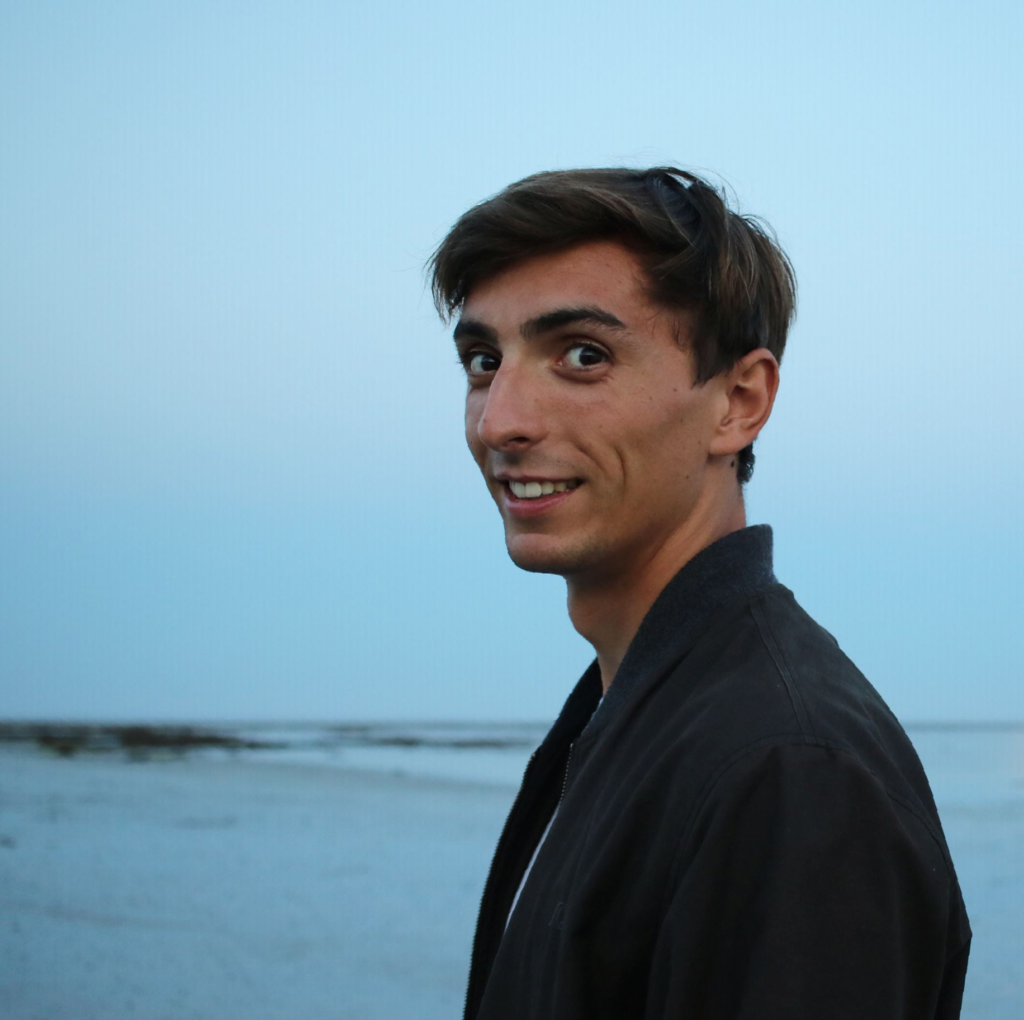
Based in Biarritz, France, and born in Nantes, France, Lodin is a surf photographer who, as well as focusing on the traditional aspects of the genre, also has a very distinctive style.
A lot of his images explore the culture and lifestyle that surrounds surfing. These are the pictures I hope to take inspiration from. He uses film for these images, and if I wish to replicate this look I may be able to buy a waterproof disposable camera, but if not, I can always edit to give the same effect (or, indeed, leave them as they are). This interview explores this sector of his work. I think it is important to note that he chooses only to shoot on film when shooting for fun; he thinks that digital images are more professional. I think that this is true to an extent, but there is certainly something to be said for the grainy nostalgia of a good film photograph. This therefore is why I may choose to actually shoot on film for these images.

My analysis of Far Enough From Home, Anthony Harouet – Thomas Lodin
Hiroshi Sugimoto
Hiroshi Sugimoto is a photographer and architect born in February 1948, in Tokyo. His earliest known photos were taken of movie footage of Audrey Hepburn as he watched it in a cinema. He studied Fine Art at the Art Center College of Design in Pasadena, California, before moving to New York, where he became a dealer of Japanese antiques.
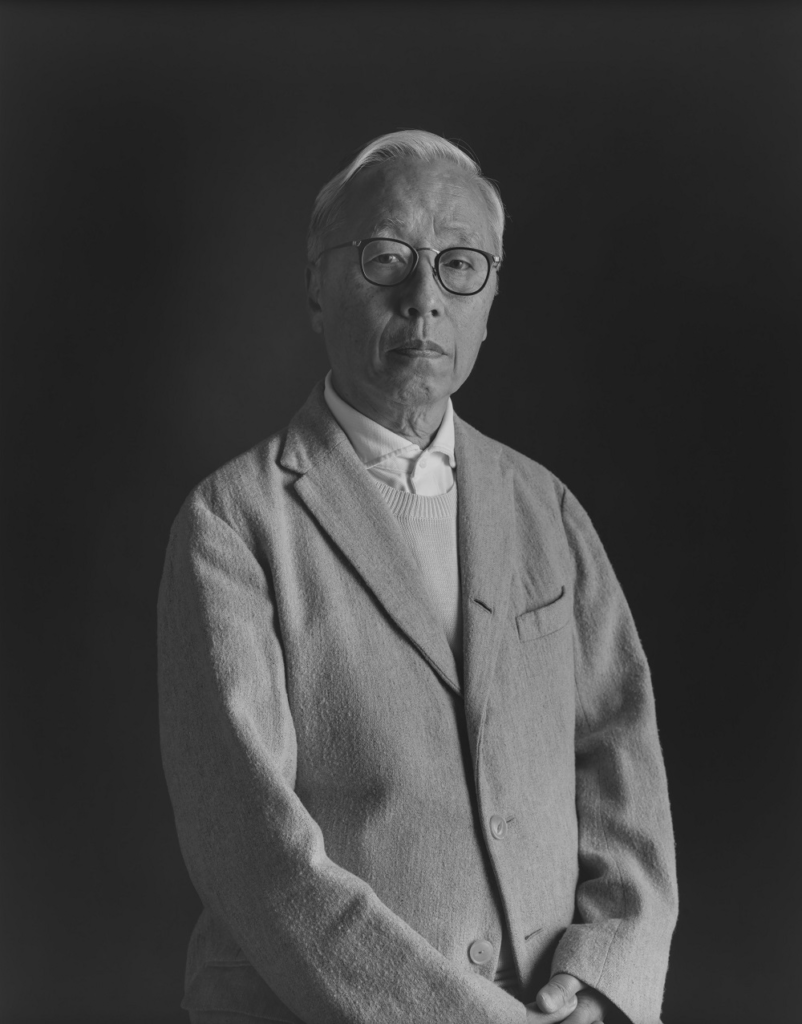
I am particularly interested by Sugimoto’s Seascapes series, taken from the 1980s to its publication as a photobook in 2015. His images are simplistic, minimalist, and contemplative. They draw on the coincidence of light, weather, calmness, and exposure to create a surprisingly dynamic yet consistent series. As an architect, it is only natural that Sugimoto should enjoy the culmination of line, shape, and form in his work, and this is demonstrated clearly in this project. Sugimoto travelled around the globe to capture the essence of each coastline through the lens of his old-fashioned large-format camera and varying lengths of exposure (up to three hours). The locations vary greatly; from Ireland to Italy, from Norway to Turkey.

Boden Sea Uttwil, 1993
All of the images are the same size and are split exactly in half by the horizon line. I enjoy Sugimoto’s images because I find beauty in their simplicity, and the use of a long exposure creates effects beyond the eye. The above image, Boden Sea, Uttwil, was selected by U2 as the cover for their album No Line on the Horizon. I will draw inspiration from this series for a few of my images in my personal study.
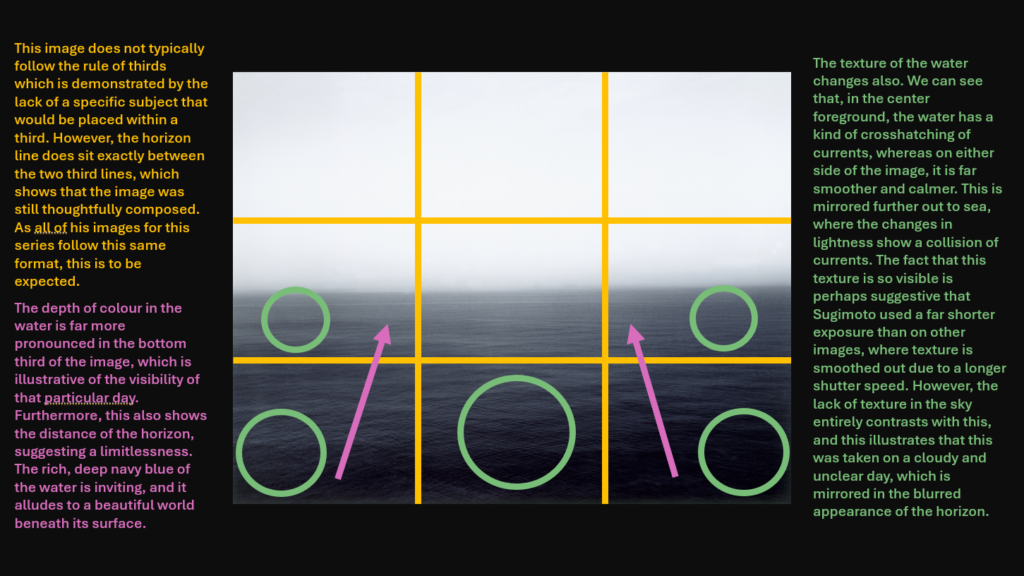
My analysis of one of Sugimoto’s Day Seascapes.
Fossils work almost the same way as photography… as a record of history. The accumulation of time and history becomes a negative of the image. And this negative comes off, and the fossil is the positive side. This is the same as the action of photography.
Hiroshi Sugimoto
Michael Marten

Born in London in 1947, Marten began taking photographs as a teenager. His first major project was Sea Change (2003-12). It has received numerous awards and been exhibited globally.
His images show the differences in landscape between high and low tides. I think these are interesting because they are demonstrative of all characteristics of a landscape between different weathers and times of day. I like these images and hope to use them as inspiration for the landscape component of my personal study.

Perranporth, Cornwall. 29 and 30 August 2007. Low water 12 noon, high water 8pm
Roni Horn
Born in New York in 1955, Roni Horn is a visual artist and writer whose work is critically acclaimed and exhibited widely throughout the western world.
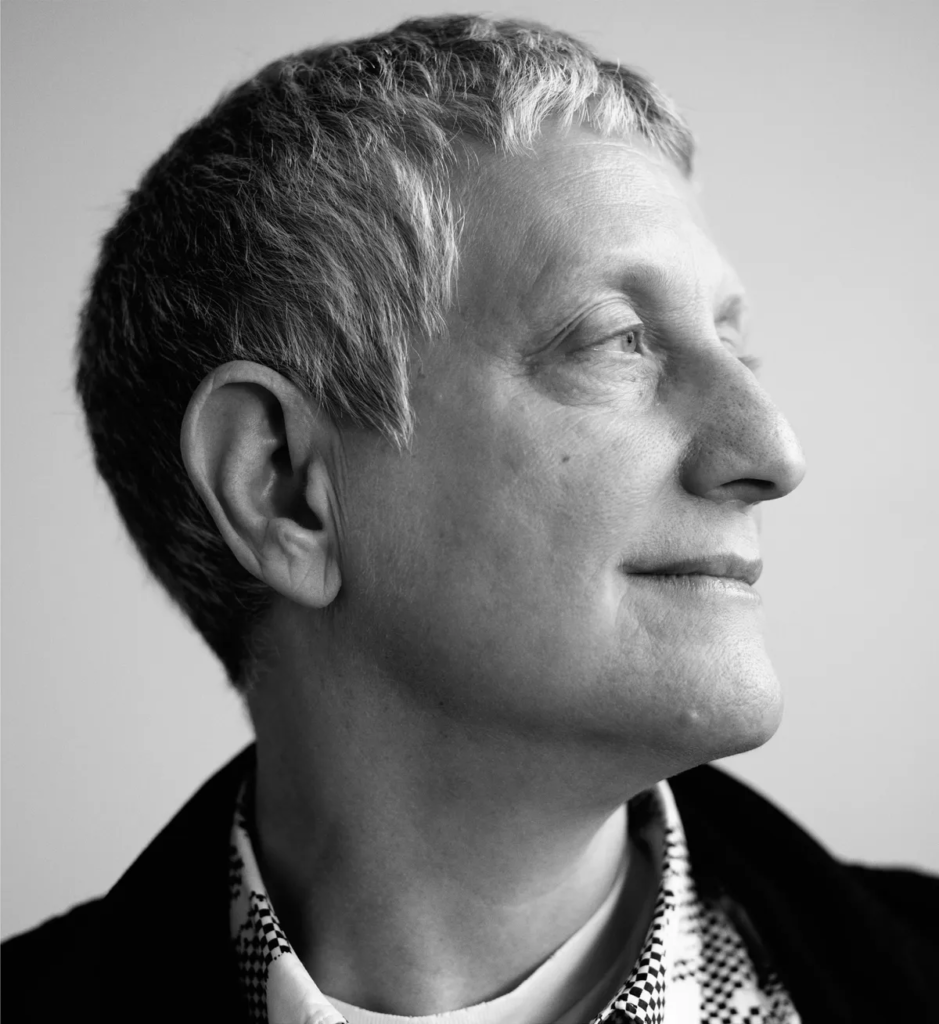
Horn mainly draws inspiration from her frequent visits to Iceland. She is fascinated by the geography, geology, climate and culture of the country, and it is the subject of her ongoing series of books, To Place (1990-). I am particularly focused on her series Dictionary of Water (winter and spring of 1999) and Still Water (The River Thames, for Example) (1999) because they are concerned with the perceptive capture of water and its textures. As a writer, Horn presents her images alongside text and footnotes that explore the unspoken ‘language’ of water (which inspires the name of the former).

This video explores Horn’s relationship with and thoughts on water, and why she thinks it is such an interesting subject for her to photograph. I will take inspiration from her work and her philosophies on water for my personal study because I think this focus on details and the meanings behind them is precisely what I would like to convey for my project. The idea of water being so much more than just water is integral to my study, as I am aiming to entirely present it in this way.
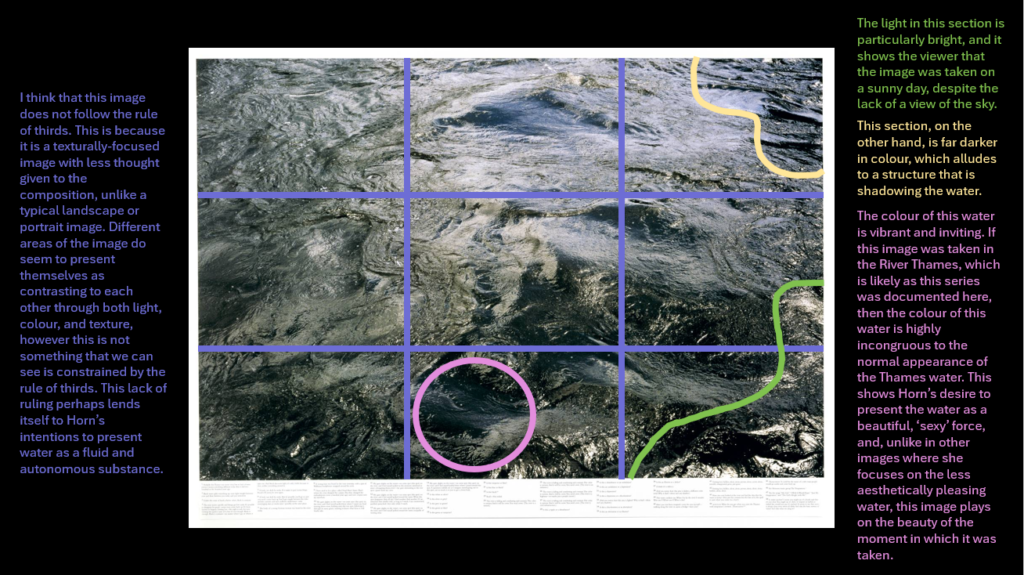
My analysis of Roni Horn’s work.
‘Thinking about water is thinking about the future.’
Roni Horn
I want to explore the story of my dad’s long and continued relationship with the sea and surfing. I will focus on how it has impacted his life and relationships as a whole, as well as my own life as his daughter.

This subject is important to me because it is essentially the reason I am here, because my parents met when my mum learned to surf and my dad was her instructor. For this reason, my whole family has been involved with the sport ever since and it affects my life every day.
I plan to ask my dad questions about how he started surfing, what draws him to it everyday, and how he feels about the sport. I will also use archived images from family albums from my dad’s life in Newquay as a young surfer and then from my parent’s history together.
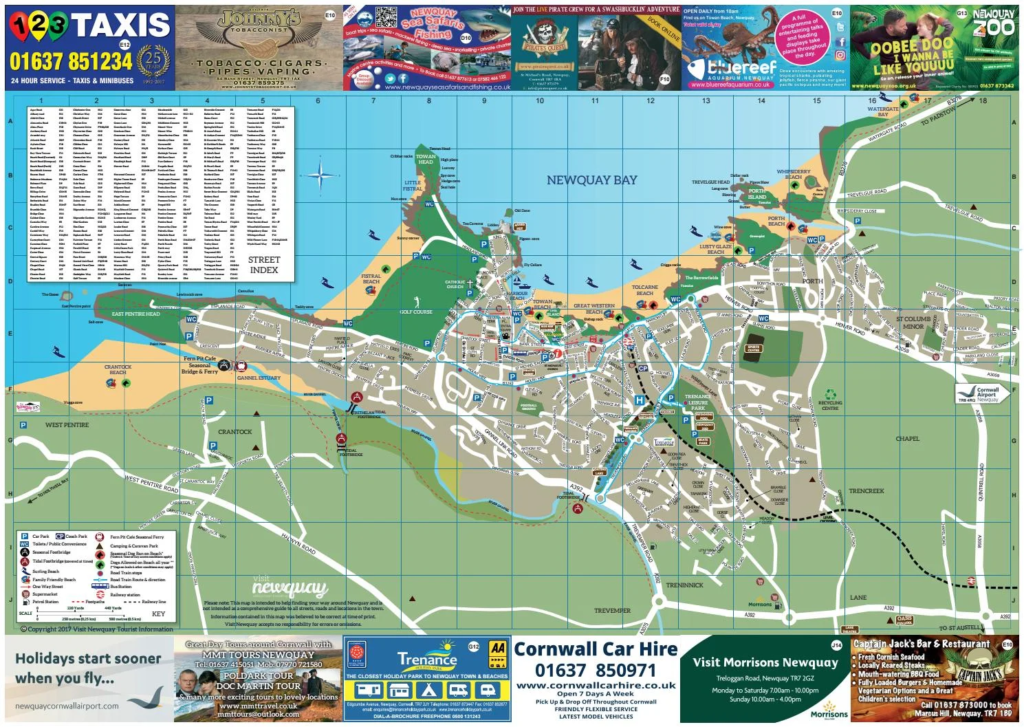
I would like to present this project as a photobook because I feel this is the most professional way for me to present my work.
I think I will begin my study by collating old images from my parent’s history to allow me to gauge the kind of material I have available and perhaps inspire my later images.
This will relate to nostalgia as it will explore my own childhood, which was spent mostly in the sea, as well as my parent’s nostalgia of when they met.
The portraits I intend to take of my dad as a surfer will be in the environmental portraiture style, although I think they will be a mixture of candid and posed images. I will also be taking images of our garage, which is full to the brim with an extensive collection of surfboards and wetsuits which my dad is constantly adding to. I could also combine this with studio images of items I found at the beach and collected as a child. I have a lot of these kind of items so this would be fairly easy to do.
I will not be able to use the studio to photograph my dad so I will either photograph him in the house, out at the beach, in the garage, or at his work as a meteorologist.
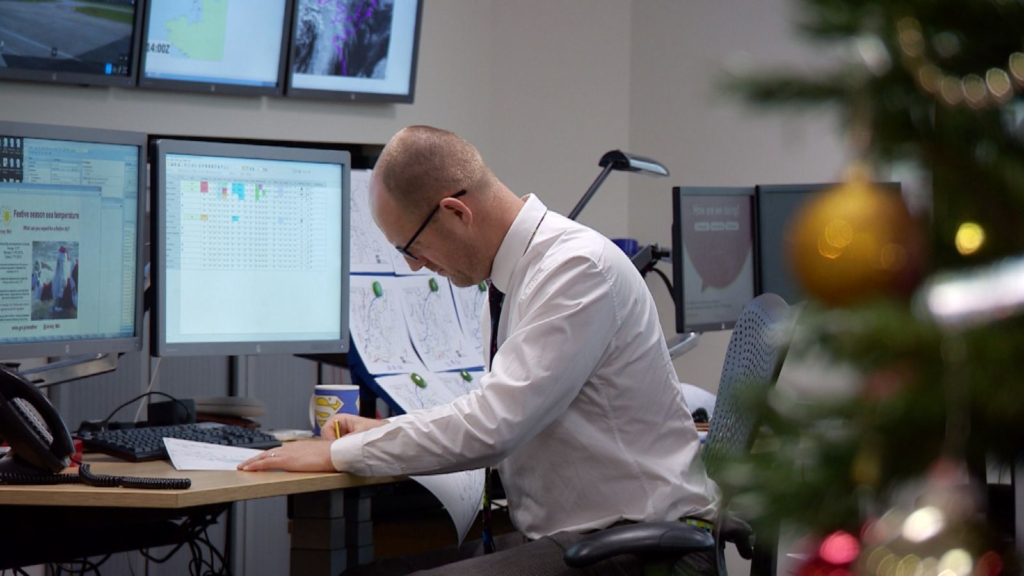
I plan to present the archive images alongside the newer images to show the differences in my dad’s lifestyle since he was younger, but also to highlight the considerable similarities. I think this is interesting as surfing can often be viewed as something done by young people, especially when done multiple times a day, however my dad does not follow this pattern. As a 49 year old father, he often finds the time to go surfing more than once a day which is quite uncommon I think. His choice of shift work over a 9-5 means that he has the ability to support this lifestyle and always find time for his hobbies.
I will accompany my images with the questions I ask my dad and then the answers that he gives.
I do not think I will choose to manipulate my images, however I will be editing them to create a more professional look but as this is an exploration of character, I think a more authentic look is important.